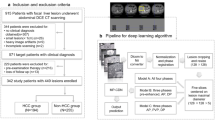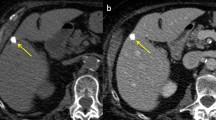Abstract
Contrast enhanced MRI of the liver provides valuable information in the evaluation of both chronic liver disease and focal liver lesions. Currently, two classes of MRI contrast agents are available for clinical use, namely the extracellular contrast agent (ECA) and the hepatobiliary agent (HBA). The use of appropriate contrast agents for liver MRI requires knowledge of the clinical situation and question to be answered. ECAs have been used for decades since their introduction into clinical practice and provide excellent dynamic phase information that is useful in characterizing focal liver lesions. In the last decade, HBAs, particularly Gadoxetate, have been found useful for characterizing lesions with functioning hepatocytes and more importantly in evaluating the biliary tree. Gadoxetate, however, provides less satisfactory dynamic phase images compared to ECAs, particularly during the arterial phase. In this perspective article, we will discuss the various intravenous contrast agents used for liver MRI and their ideal utilization.






Similar content being viewed by others
References
Gandhi SN, Brown MA, Wong JG, Aguirre DA, Sirlin CB (2006) MR contrast agents for liver imaging: what, when, how. Radiographics 26 (6):1621-1636.
Hao D, Ai T, Goerner F, Hu X, Runge VM, Tweedle M (2012) MRI contrast agents: basic chemistry and safety. J Magn Reson Imaging 36 (5):1060-1071. https://doi.org/10.1002/jmri.23725
Prince MR, Zhang HL, Prowda JC, Grossman ME, Silvers DN (2009) Nephrogenic systemic fibrosis and its impact on abdominal imaging. Radiographics 29 (6):1565-1574. https://doi.org/10.1148/rg.296095517
Ringe KI, Husarik DB, Sirlin CB, Merkle EM (2010) Gadoxetate disodium-enhanced MRI of the liver: part 1, protocol optimization and lesion appearance in the noncirrhotic liver. AJR Am J Roentgenol 195 (1):13-28. https://doi.org/10.2214/ajr.10.4392
Guglielmo FF, Mitchell DG, Gupta S (2014) Gadolinium contrast agent selection and optimal use for body MR imaging. Radiol Clin North Am 52 (4):637-656. https://doi.org/10.1016/j.rcl.2014.02.004
Hadizadeh DR, Gieseke J, Lohmaier SH, Wilhelm K, Boschewitz J, Verrel F, Schild HH, Willinek WA (2008) Peripheral MR angiography with blood pool contrast agent: prospective intraindividual comparative study of high-spatial-resolution steady-state MR angiography versus standard-resolution first-pass MR angiography and DSA. Radiology 249 (2):701-711. https://doi.org/10.1148/radiol.2492072033
Hope TA, Fowler KJ, Sirlin CB, Costa EA, Yee J, Yeh BM, Heiken JP (2015) Hepatobiliary agents and their role in LI-RADS. Abdom Imaging 40 (3):613-625. https://doi.org/10.1007/s00261-014-0227-5
Chernyak V, Fowler KJ, Kamaya A, Kielar AZ, Elsayes KM, Bashir MR, Kono Y, Do RK, Mitchell DG, Singal AG, Tang A, Sirlin CB (2018) Liver Imaging Reporting and Data System (LI-RADS) Version 2018: Imaging of Hepatocellular Carcinoma in At-Risk Patients. Radiology 289 (3):816-830. https://doi.org/10.1148/radiol.2018181494
Guglielmo FF, Kania LM, Ahmad HM, Roth CG, Mitchell DG (2016) Interpreting body MRI cases: what you need to know to get started. Abdom Radiol (NY) 41 (11):2248-2269. https://doi.org/10.1007/s00261-016-0829-1
Kim SY, Park SH, Wu EH, Wang ZJ, Hope TA, Chang WC, Yeh BM (2015) Transient respiratory motion artifact during arterial phase MRI with gadoxetate disodium: risk factor analyses. AJR Am J Roentgenol 204 (6):1220-1227. https://doi.org/10.2214/ajr.14.13677
Pietryga JA, Burke LM, Marin D, Jaffe TA, Bashir MR (2014) Respiratory motion artifact affecting hepatic arterial phase imaging with gadoxetate disodium: examination recovery with a multiple arterial phase acquisition. Radiology 271 (2):426-434. https://doi.org/10.1148/radiol.13131988
Van Beers BE, Pastor CM, Hussain HK (2012) Primovist, Eovist: what to expect? J Hepatol 57 (2):421-429. https://doi.org/10.1016/j.jhep.2012.01.031
Glockner JF, Lee CU, Mounajjed T (2018) Inflammatory hepatic adenomas: Characterization with hepatobiliary MRI contrast agents. Magn Reson Imaging 47:103-110. https://doi.org/10.1016/j.mri.2017.12.006
Kitao A, Matsui O, Yoneda N, Kita R, Kozaka K, Kobayashi S, Gabata T (2018) Differentiation Between Hepatocellular Carcinoma Showing Hyperintensity on the Hepatobiliary Phase of Gadoxetic Acid-Enhanced MRI and Focal Nodular Hyperplasia by CT and MRI. AJR Am J Roentgenol 211 (2):347-357. https://doi.org/10.2214/ajr.17.19341
Goodwin MD, Dobson JE, Sirlin CB, Lim BG, Stella DL (2011) Diagnostic challenges and pitfalls in MR imaging with hepatocyte-specific contrast agents. Radiographics 31 (6):1547-1568. https://doi.org/10.1148/rg.316115528
Chernyak V, Kim J, Rozenblit AM, Mazzoriol F, Ricci Z (2011) Hepatic enhancement during the hepatobiliary phase after gadoxetate disodium administration in patients with chronic liver disease: the role of laboratory factors. J Magn Reson Imaging 34 (2):301-309. https://doi.org/10.1002/jmri.22635
Lee NK, Kim S, Kim GH, Heo J, Seo HI, Kim TU, Kang DH (2012) Significance of the “delayed hyperintense portal vein sign” in the hepatobiliary phase MRI obtained with Gd-EOB-DTPA. J Magn Reson Imaging 36 (3):678-685. https://doi.org/10.1002/jmri.23700
Bieze M, van den Esschert JW, Nio CY, Verheij J, Reitsma JB, Terpstra V, van Gulik TM, Phoa SS (2012) Diagnostic accuracy of MRI in differentiating hepatocellular adenoma from focal nodular hyperplasia: prospective study of the additional value of gadoxetate disodium. AJR Am J Roentgenol 199 (1):26-34. https://doi.org/10.2214/ajr.11.7750
McInnes MD, Hibbert RM, Inacio JR, Schieda N (2015) Focal Nodular Hyperplasia and Hepatocellular Adenoma: Accuracy of Gadoxetic Acid-enhanced MR Imaging-A Systematic Review. Radiology 277 (3):927. https://doi.org/10.1148/radiol.2015154033
Ding Y, Rao SX, Zhu T, Chen CZ, Li RC, Zeng MS (2015) Liver fibrosis staging using T1 mapping on gadoxetic acid-enhanced MRI compared with DW imaging. Clin Radiol 70 (10):1096-1103. https://doi.org/10.1016/j.crad.2015.04.014
Hinrichs H, Hinrichs JB, Gutberlet M, Lenzen H, Raatschen HJ, Wacker F, Ringe KI (2016) Functional gadoxetate disodium-enhanced MRI in patients with primary sclerosing cholangitis (PSC). Eur Radiol 26 (4):1116-1124. https://doi.org/10.1007/s00330-015-3913-y
Nassif A, Jia J, Keiser M, Oswald S, Modess C, Nagel S, Weitschies W, Hosten N, Siegmund W, Kuhn JP (2012) Visualization of hepatic uptake transporter function in healthy subjects by using gadoxetic acid-enhanced MR imaging. Radiology 264 (3):741-750. https://doi.org/10.1148/radiol.12112061
Elsayes KM, Kielar AZ, Elmohr MM, Chernyak V, Masch WR, Furlan A, Marks RM, Cruite I, Fowler KJ, Tang A, Bashir MR, Hecht EM, Kamaya A, Jambhekar K, Kamath A, Arora S, Bijan B, Ash R, Kassam Z, Chaudhry H, McGahan JP, Yacoub JH, McInnes M, Fung AW, Shanbhogue K, Lee J, Deshmukh S, Horvat N, Mitchell DG, Do RKG, Surabhi VR, Szklaruk J, Sirlin CB (2018) White paper of the Society of Abdominal Radiology hepatocellular carcinoma diagnosis disease-focused panel on LI-RADS v2018 for CT and MRI. Abdom Radiol (NY) 43 (10):2625-2642. https://doi.org/10.1007/s00261-018-1744-4
Besa C, Lewis S, Pandharipande PV, Chhatwal J, Kamath A, Cooper N, Knight-Greenfield A, Babb JS, Boffetta P, Padron N, Sirlin CB, Taouli B (2017) Hepatocellular carcinoma detection: diagnostic performance of a simulated abbreviated MRI protocol combining diffusion-weighted and T1-weighted imaging at the delayed phase post gadoxetic acid. Abdom Radiol (NY) 42 (1):179-190. https://doi.org/10.1007/s00261-016-0841-5
Zech CJ, Justo N, Lang A, Ba-Ssalamah A, Kim MJ, Rinde H, Jonas E (2016) Cost evaluation of gadoxetic acid-enhanced magnetic resonance imaging in the diagnosis of colorectal-cancer metastasis in the liver: Results from the VALUE Trial. Eur Radiol 26 (11):4121-4130. https://doi.org/10.1007/s00330-016-4271-0
Author information
Authors and Affiliations
Corresponding author
Ethics declarations
Conflict of interest
The authors declare that they have no conflicts of interest.
Additional information
Publisher's Note
Springer Nature remains neutral with regard to jurisdictional claims in published maps and institutional affiliations.
Rights and permissions
About this article
Cite this article
Welle, C.L., Guglielmo, F.F. & Venkatesh, S.K. MRI of the liver: choosing the right contrast agent. Abdom Radiol 45, 384–392 (2020). https://doi.org/10.1007/s00261-019-02162-5
Published:
Issue Date:
DOI: https://doi.org/10.1007/s00261-019-02162-5




